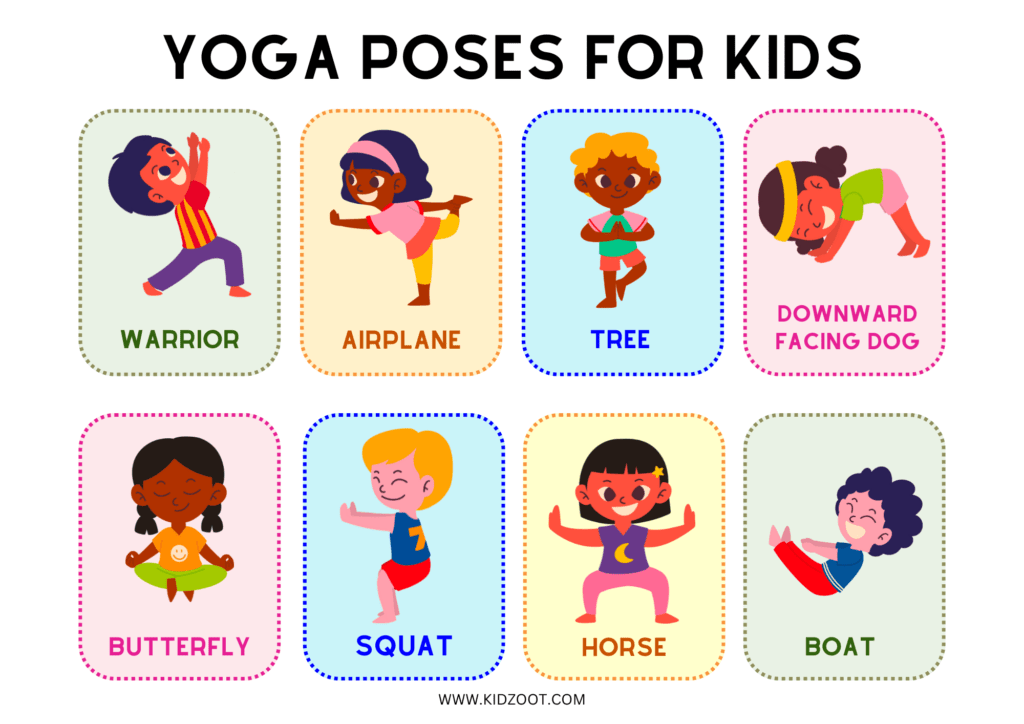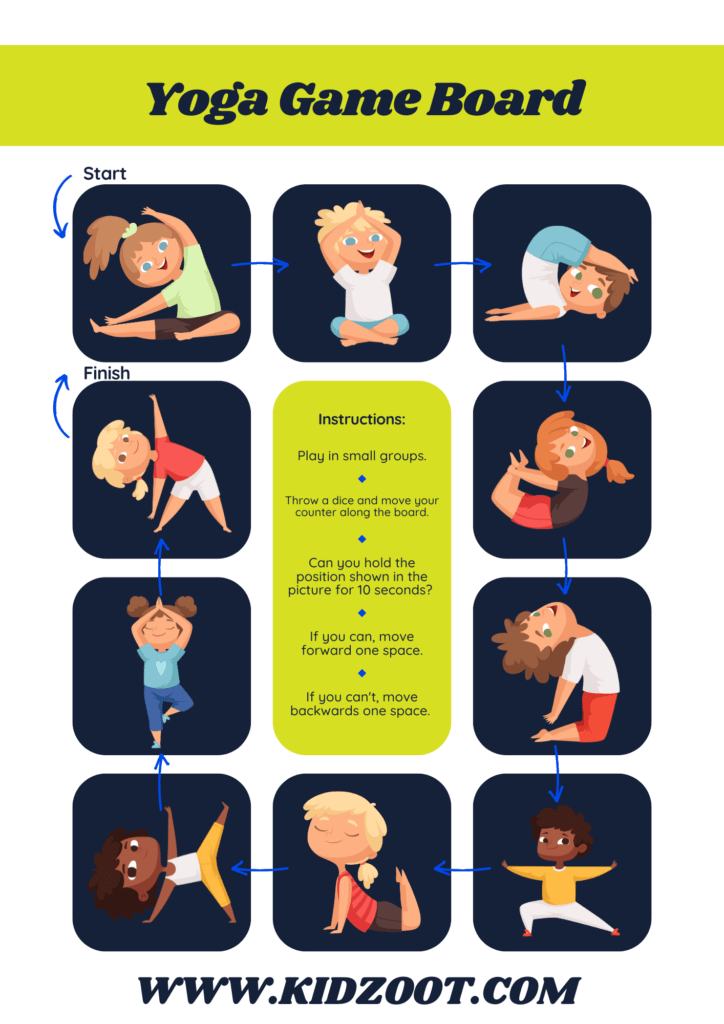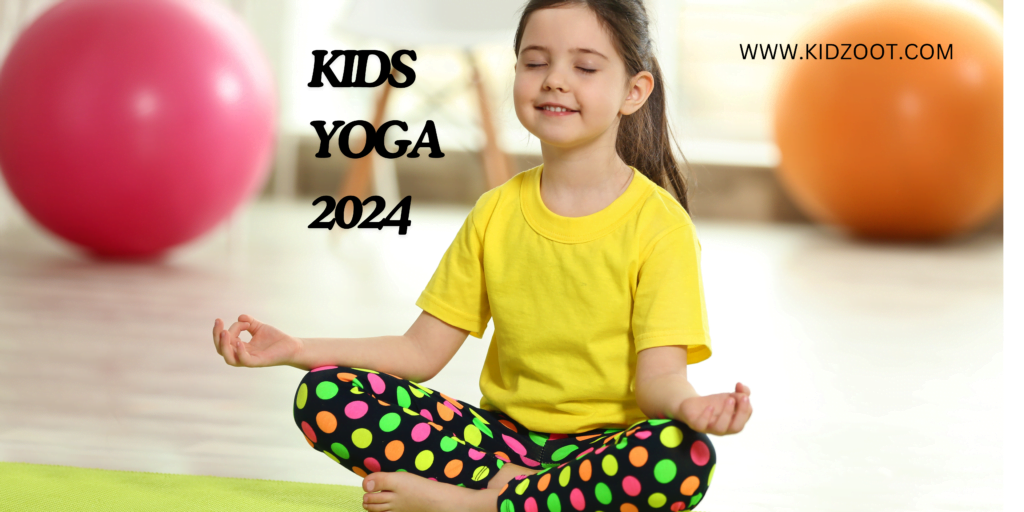Introduction: The Benefits of Yoga for Kids
Imagine a world where children are calm, focused, and full of joy. Now, picture them stretching like cats, balancing like trees, and breathing like ocean waves. Welcome to the wonderful world of kids’ yoga!
Yoga isn’t just for adults anymore. More and more parents and educators are discovering the amazing benefits of introducing yoga to children. But why is yoga so great for kids? Let’s unroll our mats and explore!
First off, yoga is a fantastic way to get kids moving. In a world where screen time often trumps playtime, yoga offers a fun and engaging form of physical activity. It helps improve flexibility, strength, and coordination, setting the foundation for a lifetime of healthy habits.
But the benefits of yoga go far beyond the physical. Yoga is like a secret superpower for kids’ minds too! It helps them learn to focus and concentrate, which can be a real game-changer in school and everyday life. Plus, the breathing techniques and mindfulness practices in yoga can help kids manage stress and anxiety, giving them tools to navigate the ups and downs of growing up.
One of the coolest things about yoga for kids is how it boosts self-esteem and body awareness. As children learn to master different poses and breathing techniques, they gain confidence in their abilities. They learn to appreciate what their bodies can do, rather than focusing on how they look.
Yoga also teaches valuable life skills like patience, perseverance, and self-control. When a child is trying to balance in tree pose, they’re not just working on their physical balance – they’re also learning to stay calm and focused even when things get wobbly.
And let’s not forget the social benefits! Yoga classes can be a great way for kids to make new friends and learn to work together. Partner poses and group activities foster a sense of community and teach kids the importance of supporting one another.
In this blog post, we’ll dive into the world of kids’ yoga, exploring fun poses, games, and activities that will have your little ones saying “Namaste” in no time. We’ll show you how to create a kid-friendly yoga space, introduce some easy and engaging poses, and even share some yoga-inspired games that will have the whole family rolling out their mats.
So, are you ready to embark on a yoga adventure with your kids? Let’s get started!
Getting Started: Creating a Kid-Friendly Yoga Space
Before we dive into the poses and activities, let’s talk about setting up the perfect yoga space for your little yogis. Creating the right environment can make all the difference in getting kids excited about yoga and helping them focus during practice.
Choose the Right Space: Find a quiet area in your home or classroom where kids can move freely without bumping into furniture. It doesn’t need to be huge – just enough space for them to stretch out their arms and legs. A corner of the living room, a cleared space in a bedroom, or even a spot in the backyard on a nice day can work wonders.
Make it Comfy: Yoga mats are great, but they’re not absolutely necessary for kids. A soft carpet or even a beach towel can do the trick. The key is to have a designated space that feels special. You might want to invest in some small, colorful yoga mats designed specifically for kids – they’ll love having their own “special” mat!
Keep it Clutter-Free: A clear space helps create a clear mind. Remove any toys or objects that might distract your little ones during yoga time. This doesn’t mean the space has to be boring, though! Which brings us to…
Add Some Yoga-Inspired Decor: Make the space inviting with some yoga-themed decorations. You could hang posters showing simple yoga poses, put up string lights for a calming ambiance, or even create a “mindfulness corner” with soft cushions and inspiring picture books about yoga.
Incorporate Nature: If possible, bring a bit of nature into your yoga space. A small plant, a bowl of smooth stones, or even pictures of natural scenes can help create a calm, grounding atmosphere.
Have Props Ready: While not essential, props can make yoga more fun and accessible for kids. Some kid-friendly yoga props include:
Small blankets or towels for comfort and warmth
Blocks or sturdy books to help with balance poses
Stuffed animals for companionship or as pose inspiration
Colorful scarves for movement exercises
Set the Mood with Music: Soft, instrumental music can help create a peaceful atmosphere. There are plenty of kid-friendly yoga playlists available on music streaming platforms. Just make sure the music isn’t too distracting – it should enhance the experience, not overpower it.
Create a Ritual: Establish a simple ritual to signal the start of yoga time. This could be ringing a small bell, taking three deep breaths together, or reciting a child-friendly yoga mantra. This helps kids transition into “yoga mode” and gets them excited for what’s to come.
Make it Accessible: Keep yoga materials within easy reach. A small basket or bin with mats, props, and any other yoga items allows kids to initiate yoga time on their own, fostering independence and enthusiasm.
Be Flexible: Remember, kids are naturally wiggly and full of energy. Your yoga space doesn’t need to be a zone of perfect silence and stillness. It should be a place where kids feel comfortable expressing themselves through movement and having fun.
By creating a welcoming, kid-friendly yoga space, you’re setting the stage for a positive yoga experience. This dedicated area will help children associate yoga with feelings of calm, fun, and special time – either with you, their friends, or in peaceful solitude.
Remember, the most important aspect of any kids’ yoga space is that it feels safe, comfortable, and inviting. With this foundation in place, your little yogis will be ready to explore the wonderful world of yoga poses and activities!
Fun and Easy Yoga Poses for Kids

Now that we have our yoga space set up, it’s time to roll out those mats and start moving! Here are some engaging and kid-friendly yoga poses that are sure to get your little ones excited about yoga. Remember, the key is to keep it fun and not worry too much about perfect form.
Mountain Pose (Tadasana) Let’s start with a simple but powerful pose. Have kids stand tall with feet together, arms at their sides. Encourage them to imagine they’re strong, tall mountains reaching up to the sky. This pose teaches body awareness and good posture. Kid-friendly cue: “Stand tall like a mighty mountain! Can you feel how strong you are?”
Tree Pose (Vrksasana) This balancing pose is great for concentration. Kids stand on one leg, placing the sole of the other foot on their inner thigh or calf (never on the knee). Hands can be at the heart or raised overhead like branches. Kid-friendly cue: “Let’s be trees swaying in the breeze. Can you stay balanced even when the wind blows?”
Downward-Facing Dog (Adho Mukha Svanasana) Kids love this one because they get to be upside down! From hands and knees, lift the hips up and back, forming an inverted V-shape. It’s a great full-body stretch. Kid-friendly cue: “Let’s make a tunnel with our bodies! Can a little mouse run under your down dog?”
Cat-Cow Pose (Marjaryasana-Bitilasana) On hands and knees, alternate between arching the back (Cow) and rounding it (Cat). This is excellent for spinal flexibility and coordination. Kid-friendly cue: “Let’s be cats and cows! Can you meow when you’re a cat and moo when you’re a cow?”
Cobra Pose (Bhujangasana) Lying on their stomachs, kids lift their chest, keeping their legs on the ground. It’s a great backbend that opens the chest and strengthens the back. Kid-friendly cue: “Pretend you’re a cobra rising up from the sand. Can you make a hissing sound?”
Warrior Pose (Virabhadrasana) This strong standing pose builds confidence. Step one foot back, bend the front knee, and raise arms overhead. It’s like a superhero stance! Kid-friendly cue: “Stand strong like a brave warrior! What’s your warrior name?”
Butterfly Pose (Baddha Konasana) Sitting with the soles of the feet together, gently flap the knees up and down like butterfly wings. It’s great for hip flexibility. Kid-friendly cue: “Let’s be beautiful butterflies! How fast can your wings flap?”
Child’s Pose (Balasana) A resting pose where kids sit on their heels and stretch their arms forward, resting their forehead on the mat. It’s perfect for calming down. Kid-friendly cue: “Time to rest like a little mouse in its cozy house. How quiet can you be?”
Frog Pose (Mandukasana) Squatting with feet wide apart and hands on the floor between the legs. Kids love to hop and ribbit in this pose! Kid-friendly cue: “Let’s be frogs at the pond! Can you hop and make frog sounds?”
Happy Baby Pose (Ananda Balasana) Lying on the back, kids hold the outside of their feet with their hands, gently rocking side to side. It’s a great way to end a session. Kid-friendly cue: “Pretend you’re a happy baby rocking in a cradle. Can you giggle like a baby?”
Remember, the goal is to make yoga enjoyable for kids. Don’t worry if the poses aren’t perfect – encouragement and fun are more important than strict alignment. Use your imagination to make the poses come alive: maybe the Warrior pose turns into a surfer riding a wave, or the Tree pose becomes a giraffe reaching for leaves.
Also, keep sessions short – 10 to 15 minutes is plenty for younger children, while older kids might enjoy up to 30 minutes. Always listen to your children and stop if they’re not enjoying it. The key is to plant the seeds for a lifelong love of yoga and movement.
Yoga Games and Activities

Yoga doesn’t have to be all quiet and serious – it can be playful and exciting too! Here are some yoga-inspired games and activities that will have your kids begging for more yoga time:
Yoga Pose Freeze Dance Put on some upbeat music and have kids dance freely. When you pause the music, call out a yoga pose. Everyone has to freeze in that pose until the music starts again. It’s a great way to practice poses while having fun!
Yoga Story Time Create a story that incorporates different yoga poses. For example, “We’re going on a bear hunt! Let’s climb the mountain (Mountain Pose), swim across the river (Freestyle swimming movements), and hide in a cave (Child’s Pose).” Let your imagination run wild!
Yoga Dice Create or purchase special dice with yoga poses on each side. Kids roll the dice and do whatever pose comes up. You can use two dice for more advanced players – one for the pose and one for how long to hold it.
Animal Yoga Call out different animals and have kids try to create yoga poses that represent them. For example, “Elephant” could be standing with feet wide apart, arms hanging down like a trunk. This encourages creativity and body awareness.
Yoga Jenga Write yoga poses on Jenga blocks. When a child pulls out a block, they (or everyone) has to do the pose written on it. It adds an element of suspense and fun to practicing poses.
Yoga Obstacle Course Set up a obstacle course where each station is a different yoga pose. Kids can move through the course, holding each pose for a set amount of time before moving to the next one.
Partner Yoga Have kids pair up to create poses together. This could be as simple as sitting back-to-back in Easy Pose, or more complex like creating a “yoga machine” where everyone connects in a pose of their choice.
Yogi Says Just like “Simon Says,” but with yoga poses. If you say “Yogi says do Tree Pose,” everyone does it. If you just say “Do Tree Pose” without “Yogi says,” anyone who does it is out.
Yoga Pictionary Write down yoga poses on slips of paper. One child draws a slip and has to act out the pose while others guess what it is. It’s a great way to reinforce pose names.
Breathing Bubble Game Have kids lie down and place a small, light object (like a feather or cotton ball) on their belly. Challenge them to take slow, deep breaths, making the object rise and fall steadily without falling off. It’s a fun way to practice mindful breathing.
Yoga Card Pick Create cards with yoga poses on them (or use store-bought yoga cards). Spread them face down. Each child picks a card and leads the group in that pose.
Nature Yoga Walk Take yoga outside! Go for a walk and use things you see in nature as inspiration for poses. A tall tree becomes Tree Pose, a rock becomes Mountain Pose, a flower becomes Lotus Pose.
Remember, the key to making yoga fun for kids is creativity and flexibility. Don’t be afraid to be silly and let the kids lead sometimes – they often come up with the most imaginative ideas!
These games and activities not only make yoga more enjoyable but also help children develop body awareness, concentration, and social skills. They learn to work together, take turns, and express themselves creatively.
As you introduce these games, pay attention to what resonates most with your kids. Some might love the active, dance-like games, while others might prefer the quieter, more imaginative activities. The beauty of yoga is that it can be adapted to suit every child’s preferences and needs.
Lastly, don’t forget to join in the fun yourself! When kids see adults enjoying yoga, they’re more likely to develop a positive attitude towards it. Your enthusiasm can be contagious, so let loose and have fun with your little yogis!
Incorporating Mindfulness and Breathing Exercises
While the physical poses of yoga are important, the practice of mindfulness and conscious breathing are equally valuable for children. These skills can help kids manage stress, improve focus, and develop emotional regulation. Here are some kid-friendly ways to introduce mindfulness and breathing exercises:
Balloon Breath Have children imagine their belly is a balloon. As they inhale, the balloon inflates (belly expands), and as they exhale, the balloon deflates (belly contracts). This visual helps kids understand deep, diaphragmatic breathing.
Bumblebee Breath (Bhramari Pranayama) Kids love this one! Have them sit comfortably, cover their ears with their thumbs, and rest their fingers on their closed eyes. As they exhale, they make a humming sound like a bee. It’s calming and fun!
Counting Breaths A simple mindfulness exercise: have kids count their breaths up to 5, then start over. It’s a great way to bring focus to the present moment.
Gratitude Circle At the end of a yoga session, have everyone sit in a circle. Each person shares one thing they’re grateful for. This promotes positivity and mindfulness of life’s blessings.
Mindful Listening Ring a bell or play a singing bowl. Ask the children to raise their hand when they can no longer hear the sound. This enhances focused listening and present-moment awareness.
Five Senses Meditation Guide kids through noticing five things they can see, four things they can touch, three things they can hear, two things they can smell, and one thing they can taste. This grounding exercise brings awareness to their surroundings.
Loving-Kindness Practice Have kids think of someone they care about (it could be a person or a pet) and silently repeat phrases like “May you be happy, may you be healthy, may you be safe.”
Color Breathing Ask children to imagine breathing in their favorite color, filling their body with it, and then breathing out a color that represents feelings they want to let go of.
Mindful Eating Bring a small, healthy snack (like a raisin or a slice of fruit) to the yoga session. Guide kids through eating it mindfully, noticing the texture, smell, taste, and sensations as they chew slowly.
Body Scan Guide children to bring awareness to different parts of their body, starting from their toes and moving up to the top of their head. This promotes body awareness and relaxation.
Mindful Movement Have kids move very slowly and deliberately, paying attention to every sensation. This could be as simple as mindfully raising their arms or walking across the room.
Worry Jar Provide kids with imaginary worry jars. They can visualize putting their worries into the jar, putting the lid on, and setting it aside. This can be a helpful tool for managing anxiety.
Incorporating these mindfulness and breathing exercises into your kids’ yoga practice can have profound effects. They learn to be more aware of their thoughts, feelings, and bodily sensations. This awareness can help them:
Manage stress and anxiety
Improve concentration and focus
Develop emotional intelligence
Enhance self-regulation skills
Foster a sense of inner calm and peace
It’s important to introduce these concepts gradually and make them age-appropriate. For younger children, keep the exercises short and playful. As kids get older, you can introduce more complex mindfulness practices.
Remember, consistency is key. Encourage kids to use these techniques not just during yoga time, but in their daily lives too. When faced with challenging situations, they can draw on these tools to help them stay calm and centered.
As parents and teachers, it’s also crucial to model mindfulness. When children see adults practicing these techniques, they’re more likely to embrace them themselves.
Lastly, always keep it positive and pressure-free. Mindfulness shouldn’t feel like a chore. If a child isn’t enjoying a particular exercise, it’s okay to try something else. The goal is to plant seeds of mindfulness that can grow and flourish throughout their lives.
By combining fun yoga poses, engaging games, and mindfulness practices, you’re giving children a holistic toolkit for physical and emotional well-being. You’re not just teaching them yoga – you’re empowering them with life skills that will serve them well into adulthood.

